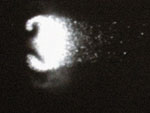Recent News
UNM Engineering team wins ASEE best paper for work on first-year engineering course
July 17, 2025
New director will enhance interdisciplinary engineering learning opportunities
July 2, 2025
Final SIRI cohort visits UNM campus
June 30, 2025
Perfetti receives ANS Landis Engineering Achievement Award
June 26, 2025
News Archives
UNM Research Group Makes Discovery in Fundamental Physics of Gases
June 1, 2011
 A research group led by Mechanical Engineering professors C. Randall Truman and Peter Vorobieff have found and documented an unexpected effect in the way a gas behaves when hit by a shock wave. It’s a discovery that may have interesting applications in many areas, including astrophysics. (Image is a vortex with trailing particles.)
A research group led by Mechanical Engineering professors C. Randall Truman and Peter Vorobieff have found and documented an unexpected effect in the way a gas behaves when hit by a shock wave. It’s a discovery that may have interesting applications in many areas, including astrophysics. (Image is a vortex with trailing particles.)
It is well documented that an effect called the Richtmyer-Meshkov instability occurs when a shock wave crosses a boundary between two gases of different densities. Swirling vortices of gas are produced by the instability. However, the UNM research shows swirling vortices also occur when a shock wave moves through a gas of the same density such as air, but in some areas in this gas, vapor droplets or smoke particles are present, which other areas are clear. “It looks like a Richmyer-Meshkov instability but it’s not,” says Vorobieff. “It’s a new class of instabilities which only develop if you have a two-phase flow.”
The experiment is straightforward. Set up a shock tube. Propel a slow jet of air seeded with droplets made by a theatrical fog machine or smoke through a hole in its wall. Then accelerate that jet with a shock wave at a Mach number 1.6 through the tube and use a short duration laser pulse to photograph what happens. The photographs show the intricate vortices and trail of particles generated by the shock of the rapidly moving gases.
See a slide show of the research group at work.
Many universities have shock tubes. It’s one of the basic pieces of equipment engineers use to test materials. UNM’s shock tube has a unique capability to photograph what happens inside the tube at the rate of 200 million frames per second. Grants from the National Nuclear Security Administration and the Defense Threat Reduction Agency allowed the purchase of the camera because it allows the team to document the movement of gas and particles in extreme detail. This discovery is also likely to have an immediate interest for astrophysicists because it shows in great detail what might happen in space when a star blows itself apart. In this photo from the Hubble Space Telescope you can see the shock wave passing through space. What you can’t see, because there is no way to view it in sufficient detail, is the exact movement of that swirling gas and dust in the wake of the wave. This experiment documents behavior of the gas and dust particles in the wake of a shock wave in an experimental setting.
The research group has written a paper “Vortex formation in a shock-accelerated gas induced by particle seeding” which was published this month in “Physical Review Letters.” The paper is co-authored by Peter Vorobieff, Michael Anderson, Joseph Conroy, Ross White and C. Randall Truman. Anderson is completing his dissertation using data from the experiment.
